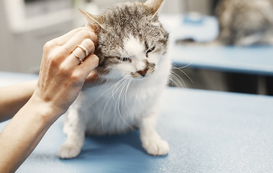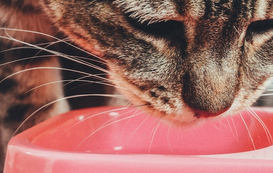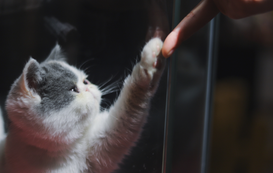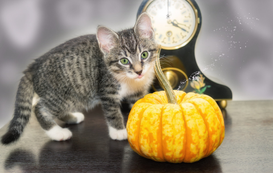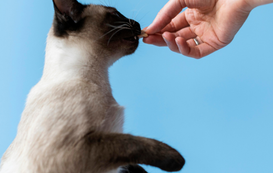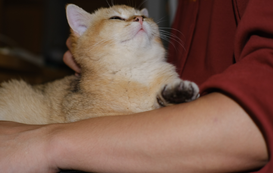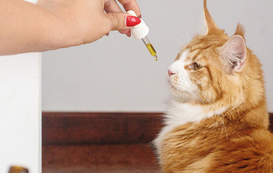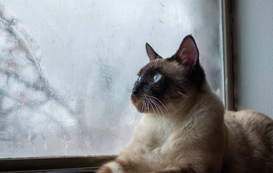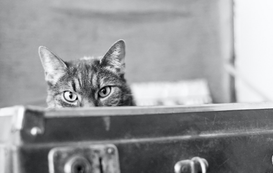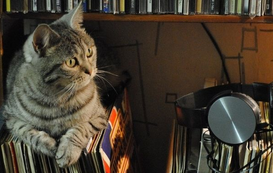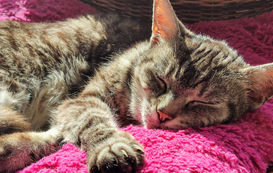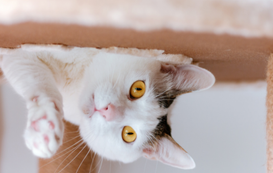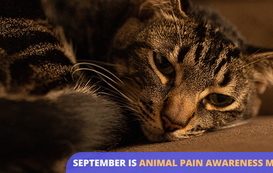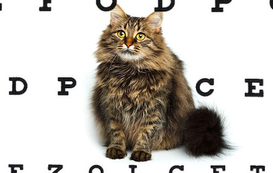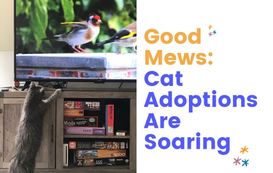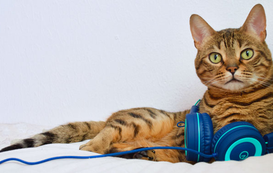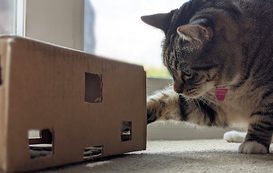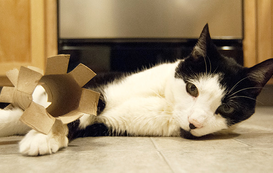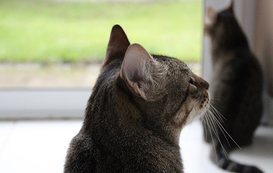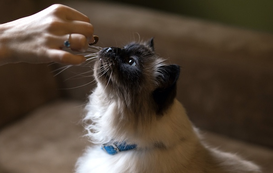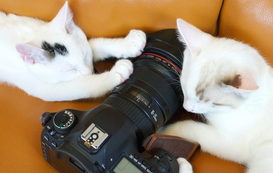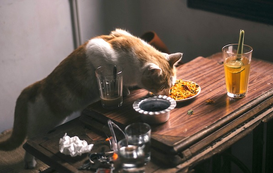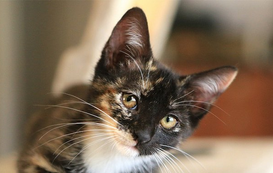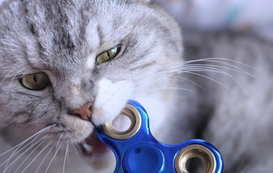Popular posts
Cat Safety – Animal Preparedness for Natural Disasters
No one likes to think of natural disasters, fires, or other emergencies affecting them or their loved ones. However, in this day and age with natural disasters happening more frequently than ever and the general unpredictability of life, it’s better to be prepared than to be caught off guard. For most people who live in disaster-prone areas, it’s common practice to have a go bag and a plan, but for others who might not live in these areas, what exactly is a go bag, what should be in it, and how does one make an evacuation plan?
Since I live in Los Angeles and I am terrified of earthquakes, I have two different go bags. I have one in case I’m trapped in my apartment which includes 7 gallons of water, a fire extinguisher, and a shelf of nonperishable food. I also have a hiking backpack under my bed. This bag has vital items for any emergency – including a zombie apocalypse (have you seen I Am Legend?!). I have a crank Ham radio, phone chargers, flashlights with extra batteries, a desalinating water filter, duct tape, eye glasses, cash, meds, first aid kit, face breathing masks, socks, hand and feet warmers, a change of clothes, a mylar thermal blanket, contacts, water, passport, waterproof matches, and MREs. What about Max? Don’t worry, I have stuff for him, too! In that hiking backpack, I have his food, collapsible bowls, medication, his records, pee pads, and diapers. However, after doing some research, I found that what I have packed for Max isn’t enough. So, I’m making my list and checking it twice – à la Mr. Claus – to make sure I have everything I need to keep my bubba safe.
Before purchasing the items to keep in your go bag and making your actual evacuation plans, it’s good to have a checklist so things don’t get too overwhelming while you prepare:
- Is your cat microchipped and registered?
- Does your cat have an up to date collar and tag?
- Do you have a rescue alert sticker?
- Do you have an evacuation plan, including where you’d go?
- Do you have extra food, water, and medication?
- Is your carrier easily accessible and near the front door?
- Do you have a go bag with items for you and your cat(s)?
Microchip
Microchipping is still optional in the United States, but it has become common practice among pet owners (dog and cat alike). So, as a cat parent who is doing their due diligence, it’s a reliable measure that can be helpful in identifying your cat if you get separated. The main companies are HomeAgain and Avid. Normally, you don’t have the option of the brand as vet offices tend to use one company or another. The reason the brand is important is because you’ll need to register the microchip with the correct company. Sometimes vet offices will register the microchip for the parents, but it isn’t the norm. It is vital to register your cat’s microchip! The registration is what associates their microchip number with your contact information.
Once the microchip is registered, it’s critical that all of the pet and contact information remains up to date. Max’s microchip was registered when he was first chipped in 2015, but I hadn't changed his info until now when I was writing this article. I updated his pet profile as he’s developed many health issues and has lost weight. I made sure there was a current photo of him on his profile as well. Once I made the changes with HomeAgain, I verified the registration was complete by double checking his microchip number at AAHA Universal Pet Microchip Lookup.
Collar and ID Tag
Many people don’t think their cat needs a collar and ID tag because their cat is strictly indoors. While this seems like sound logic, the fact of the matter is anything can happen. If something happens while you aren’t home and Fluffy gets out, having a tag is the quickest way to get her back to you.
What info should the ID tag have?
- Your cat’s name
- Your name
- Your phone number
- Your address
- Your cat’s microchip ID number
Rescue Alert Stickers
Do you have a rescue alert sticker for your home? While many people I know do, I didn’t. Luckily, ASPCA will send you a free pet alert sticker so I signed up to get one. The best placement for these stickers is by your front door–either in a window next to the door or even on the door itself. The ASPCA suggests that if you and your pet have evacuated from an emergency, write “EVACUATED” on the sticker so that First Responders won’t waste precious time looking for Fluffy when they could be helping others. 1
Evacuation Plan
While microchips and ID tags are important, it’s also essential to have a plan of action should you need to evacuate. It’s ideal to have your cat carrier and your go bag close to the exit of your home. I live in a studio so my go bag and carrier are under my bed, which is approximately 7 feet from my door.
Look into pet friendly hotels within a fair distance of home or have a friend you can bring your cat to as many human disaster relief shelters don’t allow animals. However, if a shelter is where you plan on going, be sure to know which ones allow pets. Have multiple options in place for where you will go, should one or more location be full. It’s also wise to have multiple routes planned in advance in case any evacuation routes become blocked.
It’s not a bad idea to have a trusted friend or family member be your emergency pet contact. This person should know your cat and have a set of keys should they need to help Fluffy. I don’t have any family in California so a friend and client of mine has a set of keys for Max, and I have a set of keys for her pet, Lola. She knows Max’s medication and feeding routine which is key for a high maintenance senior kitty.
Go Bag
The American Veterinary Medical Association (AVMA) suggests the following items for your go bag for Fluffy: 2
Food and Medicine
- 3-7 days' worth of dry and canned (pop-top) food*
- Two-week supply of medicine*
- At least 7 days' supply of water
- Feeding dish and water bowl
- Liquid dish soap
*These items must be rotated and replaced to ensure they don't expire
First Aid Kit
- Anti-diarrheal liquid or tablets
- Antibiotic ointment
- Bandage tape and scissors
- Cotton bandage rolls
- Flea and tick prevention (if needed in your area)
- Isopropyl alcohol/alcohol prep pads
- Latex gloves
- Saline solution
- Towel and washcloth
- Tweezers
Sanitation
- Litter, litter pan, and scoop (shirt box with plastic bag works well for pan)
- Newspaper, paper towels, and trash bag
- Household chlorine bleach or disinfectant
Important Documents
- Identification papers including proof of ownership
- Medical records and medication instructions
- Emergency contact list, including veterinarian and pharmacy
- Photo of your pet (preferably with you)
Travel Supplies
- Crate or pet carrier labeled with your contact information
- Extra collar/harness with ID tags and leash
- Flashlight, extra batteries
Comfort Items
- Favorite toys and treats
- Extra blanket or familiar bedding
In addition to the above items, it wouldn’t hurt to put your vet’s information with Fluffy’s medical records. FEMA says “a picture of you and your pet together will help you document ownership and allow others to assist you in identifying your pet. Include detailed information about species, breed, age, sex, color, and distinguishing characteristics” should you and Fluffy be separated. 3
The Actual Evacuation
Take your cat(s) with you! The Humane Society states, “Rule number one: If it isn't safe for you, it isn't safe for your pets. You have no way of knowing how long you'll be kept out of the area, and you may not be able—or allowed—to go back for your pets.” 4 With that said, if you evacuated without them, do not try to re-enter the structure on your own.
I know this sounds completely ludicrous, but try to be as calm as you can. Remember, Fluffy and Peanut can sense your nerves, and it’s likely that they hate being in their carriers. If you are panicking, Fluffy and Peanut may run and hide. Stay calm so you can corral your cats into their carriers and leave quickly and safely. Once you, Fluffy, and Peanut vacate safely, head to your previously selected evacuation location, and listen for emergency updates.
While thinking of a situation like this may cause a severe amount of anxiety, it’s better to be prepared than to be blindsided. If you live in a disaster-prone area, talk to your Meowtel sitter about your evacuation plan. Since your sitter likely has many clients, it would behoove everyone to have a list printed out in an easy-to-spot location (i.e. fridge, bulletin board, or back of the front door) so if your sitter needs to grab Peanut and evacuate, they know your plan.
- Disaster Preparedness. Retrieved from https://www.aspca.org/pet-care/general-pet-care/disaster-preparedness
- Pets and Disasters. Retrieved from https://www.avma.org/public/EmergencyCare/Pages/Pets-and-Disasters.aspx
- Preparing for Your Pets Makes Sense. Get Ready Now. Retrieved from https://www.fema.gov/media-library-data/1390846777239-dc08e309debe561d866b05ac84daf1ee/pets_2014.pdf
- Make a disaster plan for your pets. Retrieved from https://www.humanesociety.org/resources/make-disaster-plan-your-pets
Photo by Tranmautritam via Pexels










